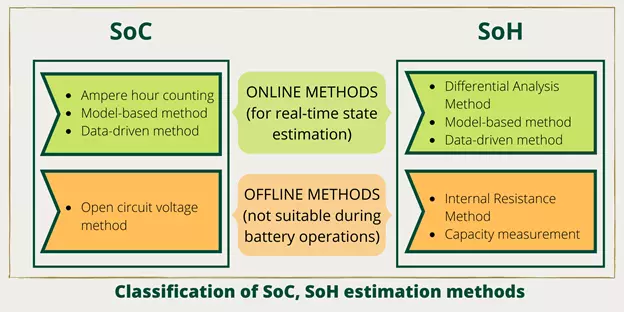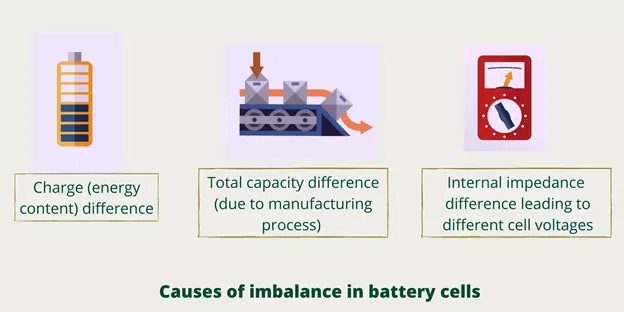
Table of Contents
BMS in Electric Vehicles
Rechargeable batteries are used to deliver power to the auxiliary systems and motors in electric vehicle applications. Among all rechargeable batteries, Lithium-Ion Batteries will give high efficiency for electric mobility because Li-Ion batteries have a low self-discharge rate, wide operating range, maximum energy density, and high life cycle.
To improve the quality of the battery and safe operation, a Battery Management System (BMS) is employed and it plays a vital role in the application of Electric Mobility.
here is the Why do we require Battery Management System (BMS) in Electric vehicles?
Why Battery Management System (BMS) in Electric Vehicles?
To prevent battery failure and mitigate potential hazardous situations, there is a need for a supervising system that ensures that batteries function properly in the final application. This supervising system is referred to as a Battery Management System (BMS).
Read More: Thermal Management Systems (TMS) for Electric Vehicles
Functions of Battery Management System in EV
The primary function of a BMS is to fulfill safety requirements. But there’s more to it. Objectives related to the more efficient usage of battery cells and prolongation of their lifetime are also being increasingly integrated into the design of BMS.
While there is no unique definition of a BMS, it should be designed with a minimal set of requirements Such as-
- It must measure individual cell voltages
- The BMS must measure temperatures at different points as close as possible to the battery
- It must measure currents flowing through it
- The BMS should communicate information to control units and undertake action to ensure the battery will be operated within safety limits
- The BMS should balance battery cells passively or actively
- And, the BMS should provide thermal management

Battery State Parameters
For the management of the batteries during electric vehicle operation, to achieve the best performance and prolong battery life, it is necessary to monitor various states inside the battery depending on the battery management system (BMS) in real-time.
These states include state of health (SoH),state-of-charge (SoC), state-of-function (SoF), charge acceptance (CA), etc.
State of Charge (SoC)
All vehicles have a fuel indicator, in the same way, EVs also have a battery state of charge (SoC) indicator. BMS helps in indicating and showing the driver the actual state of charge in the battery.
The SoC of a cell is a percentage value that expresses the remaining charge Q of a battery.
State of Health Definition (SoH)
With advancing battery degradation, the internal resistance of the battery increases while the capacity of the cell fades. This leads to drastic changes in cell behavior and might make a cell unsuitable to be used for its primary application, such as in an EV.
Therefore, it is necessary to track the cell degradation, using the parameter state of health (SoH). The battery SoH characterized by the slow-changing parameters, such as capacity fading and resistance increasing, varies with cycles and hence it needs to be monitored in a long timescale.
State of function definition (SoF)
In simple words, SoF can be defined as a parameter that describes how a battery’s performance meets the application’s demands during use.
The SoF can either be a percentage value, a concrete value in, for example, kW, or even a binary value representing whether the battery is or is not able to fulfill the demand of the application.
A more generalized definition of SoF can be as the fraction of the ΔP (difference of available power to demanded power) to the ΔPmax (difference of maximum power battery pack can supply to demanded power), that is, it is a percentage value that describes how much the current battery state (SoC, SoH, temperature, etc.) differs from the optimal battery state.
Charge acceptance (CA)
It indicates the maximum charging current the battery can accept at present conditions (SoC, SoH, temperature) and for a given charging voltage and is therefore highly relevant for regenerative braking.
However, both SoC and SoH cannot be directly measured by the sensors, they are only monitored and reflected based on the measured parameters such as voltage, current, temperature, and internal resistance.
A variety of methods have been developed for both SoC and SoH estimation. Considering the practical applications, the methods can be roughly categorized into online and offline ones.
The online methods can be used for the real-time state estimation of the battery. However, the offline methods are not suitable during battery operations due to strict experimental schemes or high computational costs.
Classification of Soc, SoH Estimation Methods

Beyond the basic functionality of a BMS for hybrid electric vehicles (HEVs)/ battery electric vehicles (BEVs) of measuring cell voltages, cell temperatures, and the current flowing through the battery pack, automotive BMS must provide methods for charge equalization of imbalances between the individual cells of a multi-cell battery system to increase both the cell lifetime and the usable energy in each discharge cycle.
Battery Cell Balancing
The imbalances between the cells are exacerbated by continual charge/discharge cycles if they are not corrected, which results in drifting apart of the cells. Cells with less total capacity than the best performing cells in the system could become overcharged, which causes those cells to degrade prematurely.
This degradation leads to a capacity fade and consequently accelerates the original problem. Additionally, this overcharging can become a safety hazard as it might cause active components in the battery to react with each other and cause a thermal runaway.
Causes of Imbalance in Battery Cells

Classification Systems for Balancing Methods
There are different classification systems for balancing methods.
Static Methods
Static methods: Methods that are either carried out before the pack is in operation or are not controllable by the BMS once the pack is in operation.
Dynamic methods
Dynamic methods: Balancing methods that are controllable by the BMS, further divided into active and passive methods. The active cell balancing technique uses inductive charge shuttling or capacitive charge shuttling to transfer the charge between the cells.
This technique is proven to be an efficient approach as it transfers energy to where the energy is needed instead of wasting it.
However, this demands additional components to be added to the system which in turn translates to increased cost. The passive cell balancing technique uses the idea of discharging the cells through a bypass route that is mostly dissipative in nature.
It is simpler and easier to implement than active balancing techniques as the bypass can either be external or be integrated — keeping the system more cost-effective either way. However, since all the excess energy is dissipated as heat, battery run time is adversely impacted and is less likely to be used during discharge.
Adopting precise cell balancing achieves a larger capacity for the intended application because the state of charge (SoC) that can be accomplished is higher.
Keep Reading Keep Exploring:)








Please send the copy of the above
Please send the copy of the abov